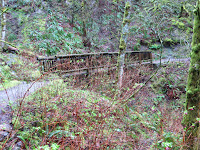
Springing from winter's hibernation our happy hiking group gathered, quivering with pent up energy to make the first excursion of the new year into the woods.
Catherine Creek, part of the Columbia River Gorge Scenic Area, lies between Bingen and Lyle on the Washington side of the river and offers a first glimpse of the wildflower frenzy about to burst throughout the territory. It also allows warmer and drier hiking due to its eastern location.
Invigorated by the early morning spring-like weather, we piled into cars and chatted our way east, catching up on each other's winter activities and travels. Crossing the Columbia River at Hood River, we turned east along Highway 14 to reach Old Highway 8 where the trailhead begins. Expansive skies, laden with layers of light gray cirrostratus clouds caused a halo effect around the sun rising in its southern arc. Absent was the customary Gorge breeze and thus a mirror-like surface lay over the entire river. No wind surfing today.
A lower, paved trail winds in two three-quarter mile loops over the river-hugging cliffs, a popular nesting ground for peregrine falcons later in the spring. With only the occasional wind-blown Ponderosa pine to frame a view, the upper reaches of the Columbia River are seen as a wide, serpentine trail of water slowly making its way to the Pacific Ocean. The scene evokes tales of various local Indian tribes meeting nearby and the Lewis and Clark exploration party trading with them for supplies and
information. Hushed by these thoughts I stood silently, letting the cool air swirl softly around me and the view transport me to a different time and place.
 |
| Desert biscuits |
 |
| Stream crossing |
 |
| The Arch at top |
Stepping around rivulets of seeping water we entered the upper trail to begin our climb to The Arch and an old homestead. Basalt cliffs stand as tall overseers of vast fields of glacial till, remnants of receding glaciers. Water percolates through this porous structure to travel downhill in tiny streams, gathering in small ravines which channel it into singing waterfalls on its way to the mighty Columbia.
The trail is a gentle climb, branching east and west halfway up the hill. Taking the eastern route we made our way to the first summit where a carpet of purple, white, yellow and silver
wildflowers grew as if strewn by by an unseen hand. Desert Widow, Columbia as well as Smooth Desert Parsley, the tiny Columbia Gorge daisy, newly leafing lupine and several varieties of saxifrages tint the greening rocky hillside with their colors.
Traversing the hilltop we stopped to view the top of The Arch, a natural bridge structure formed when part of the ridge rim fell away, leaving a gap in the basalt cliff. From the early part of the trail below it appears as a cave above an avalanche of talus. Considering the piles of rocks that have fallen away from the cliff we step back and stroll along a pole fence line to stop for lunch and take in the view upriver towards The Dalles. Puffy stratocumulus clouds begin to dot the bluing sky and sunbeams make their way to the pasture to warm us. Cattle once roamed this rocky area, subsisting on the scrawny grasses. Relics of past ranching are losing the battle with time and decay as nature reclaims its territory.
 |
| Desert Widow |
Joining the watery runoff we hop-scotch down the trail, avoiding the more swampy areas by stepping on the flatter stones that clutter the path. More swaths of wildflowers color the landscape and we stop to examine them up close for their dainty details. Across the river at Memaloose Hills the wildflower display tends toward acres of brilliant yellow arrow-leaf balsamroot and deep purple lupine in mixed bouquet arrangements.
There is no more colorful time to visit the profuse wildflower displays frosting the hillsides of the Gorge.
Start in the drier, eastern end around Mosier, The Dalles and Arlington and work your way west and into the Coastal Range to Saddle Mountain. You won't be disappointed unless you forget your camera. Happy hiking in 2016!
 |
| Rocky soil supports profuse wildflowers |
 |
| Steel, our trail dog |
 |
| Colorful carpet |
 |
| Watery trail |
 |
| Lunch spot |
 |
| Lupine just leafing out |
 |
| Moss |
 |
| Looking down over The Arch to bridge |
 |
| Desert Widow and Gold star daisy |
 |
| The Gorge looking east |
 |
| Desert parsley |
 |
| Ancient fencing returning to the earth |
 |
| Saxifrages soaking in mossy rocks |
 |
| Rivulets of runoff |
 |
| Yellow desert parsley |
 |
| Partial list of wildflowers by month |

















































